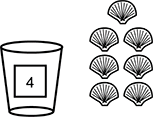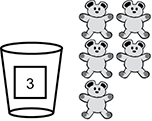Test Information Guide
Field 72: Early Childhood
Sample Open-Response Item
The following materials contain:
- Sample test directions for the open-response item
- A sample open-response item
- An example of a strong response to the open-response item
- The scoring rubric
Sample Test Directions for Open-Response Items
This section of the test consists of two open-response item assignments. You will be asked to prepare a written response of approximately 150–300 words for each assignment. You should use your time to plan, write, review, and edit your response for each assignment. You must write responses to both of the assignments.
For each assignment, read the topic and directions carefully before you begin to work. Think about how you will organize your response.
As a whole, your response to each assignment must demonstrate an understanding of the knowledge of the field. In your response to each assignment, you are expected to demonstrate the depth of your understanding of the subject area by applying your knowledge rather than by merely reciting factual information.
Your response to each assignment will be evaluated based on the following criteria.
- PURPOSE: the extent to which the response achieves the purpose of the assignment
- SUBJECT KNOWLEDGE: appropriateness and accuracy in the application of subject knowledge
- SUPPORT: quality and relevance of supporting evidence
- RATIONALE: soundness of argument and degree of understanding of the subject area
The open-response item assignments are intended to assess subject knowledge. Your responses must be communicated clearly enough to permit valid judgment of the evaluation criteria by scorers. Your responses should be written for an audience of educators in this field. The final version of each response should conform to the conventions of edited American English. Your responses should be your original work, written in your own words, and not copied or paraphrased from some other work.
Be sure to write about the assigned topics. You may not use any reference materials during the test. Remember to review your work and make any changes you think will improve your responses.
Sample Open-Response Item
Objective 0011
Prepare an organized, well-developed analysis on a topic related to the development of concepts and processes related to mathematics.
Assignment
Use the information provided in the exhibits to complete the assignment that follows.
Using your knowledge of foundational mathematics skills and mathematics content and pedagogy, write a response of approximately 150–300 words in which you:
- identify one area of strength that the child demonstrates related to the mathematics content skill specified;
- identify one area of need that the child demonstrates related to the mathematics content skill specified;
- describe a learning activity that would address the child's identified need and promote progress toward the specified mathematics content standard; and
- explain why this learning activity would be effective for the child.
Be sure to cite specific evidence from the exhibits provided to support all parts of your response.
Exhibit 1
Lesson Plan
A prekindergarten class will name written numerals zero through ten and demonstrate one-to-one correspondence when counting objects up to ten. The following is an excerpt from the teacher's lesson plan.
Learning Objectives:
- Children will name written numerals zero through ten.
- Children will count to answer the question "How many?"
Essential Questions:
- What is counting?
- How can numbers represent objects?
Foundational Skills:
- verbally counting to ten
- identifying that the last number said is the number of objects counted
Vocabulary Words:
the numbers zero through tenActivity:
- Large, colorful written numerals will be distributed to children. During a read-aloud activity featuring written numerals and illustrations representing quantities, children will be asked to raise their numbers once they are seen or heard in the story.
- Children will be encouraged to count aloud in unison as the objects in the illustrations are pointed to by the teacher.
- Children will work in groups of three for center-based activities focusing on written number identification, counting using one-to-one correspondence, and sorting quantities.
Exhibit 2
Work Sample
For one of the center-based activities, children are instructed to count out objects for a given written numeral to be placed in corresponding cups. The conversation between the teacher and the child is shown below.
Teacher-Child Counting Conversation
Child: I have four hearts.
Teacher: You sure do! What is the number on the cup?
Child: It goes like this. (Air-draws the number two.)
Teacher: I like how you drew that with your finger. That is the number two.
Teacher: Can you show me two?
Child: One, two! Two hearts!
There is a cup on the left labeled with the numeral 4. 7 seashells are arranged in 3 rows of 2 with one seashell directly above the rows to the right of the cup.
Teacher: How many seashells are in your cup?
Child: I have one, two, three, four, five, six, seven. I have seven seashells.
Teacher: You are right! You have seven seashells! What is the number on the cup?
(The child shrugs while playing with the seashells.)
Teacher: Four. This is the number four. Let's use our finger to make the number four.
Teacher: Can you show me four seashells?
Child: One, two, three, four. Four seashells right here.
There is a cup on the left labeled with the numeral 3. 5 bears are arranged in three rows with 2 bears in the first and second row and one bear in the third row.
Teacher: What number is this on the cup?
Child: Five?
Teacher: This is the number three. How many bears should be in this cup?
Child: Three.
Teacher: How many bears are in your cup?
Child: I have one, two, three, four, five bears. Five bears.
Teacher: You have five bears for the number five!
Sample Strong Response to the Open-Response Item
The sample response below reflects a strong knowledge and understanding of the subject matter.
The student's strength is the ability to count the correct number of objects upon teacher request. The student demonstrated one-to-one correspondence and the ability to identify amounts from 0-10 when directed by the teacher. This is supported by the teacher's conversation with the student during an opportunity for the student to demonstrate one-to-one correspondence from 0-10 as they counted three different amounts (four, seven, and five) of three different objects.
The student's need is recognizing written numerals and their quantities. The student did not recognize the numerals in the activity unless the teacher named them first. The student was unable to name the numerals 5, 7 and 2 on cups. The student counted out 7 seashells but ignored the teacher's comment that the numeral "4" was on the cup. Hearing the teacher say this, the student was able to count out 4 shells. Attempting to count items/bears, the student did not attend to the cup's numeral, but concentrated on having counted 5 bears.
The student requires hands-on experiences that visually links the number of objects with the written numeral itself. The teacher will give the student direct, explicit instruction on a one-to-one basis to teach this skill. Interventions would include the teacher modeling and the student practicing the following: using hands-on 3-D numerals and linking them to the written numerals, tracing the numeral on paper, and matching it to the correct number of objects. The teacher will read a picture book that shows a different number of items on each page. The student has number cards (1 to 10). After the teacher reads each page, the student says and shows the correct number card corresponding to the amount. Next, the teacher has a stack of number cards (1 to 10). The student has a box of counting items. The teacher holds up a number card and asks the student to count out the number of items represented by the number on the card. When the student is correct, the student places the items in a bowl until the bowl is filled.
This would be effective in assisting the student in learning to recognize written numerals 0 to 10, seeing the numerals as representing quantities, and knowing which written numeral represents which quantity.
Scoring Rubric
Performance Characteristics
The following characteristics guide the scoring of responses to the open-response item(s).
| Purpose | The extent to which the response achieves the purpose of the assignment. |
|---|---|
| Subject Matter Knowledge | Accuracy and appropriateness in the application of subject matter knowledge. |
| Support | Quality and relevance of supporting details. |
| Rationale | Soundness of argument and degree of understanding of the subject matter. |
Scoring Scale
The scoring scale below, which is related to the performance characteristics for the tests, is used by scorers in assigning scores to responses to the open-response item(s).
| Score Point | Score Point Description |
|---|---|
| 4 |
The "4" response reflects a thorough knowledge and understanding of the subject matter.
|
| 3 | The "3" response reflects an adequate knowledge and understanding of the subject matter.
|
| 2 | The "2" response reflects a limited knowledge and understanding of the subject matter.
|
| 1 | The "1" response reflects a weak knowledge and understanding of the subject matter.
|
| U | The response is unrelated to the assigned topic, illegible, primarily in a language other than English, not of sufficient length to score, or merely a repetition of the assignment. |
| B | There is no response to the assignment. |





